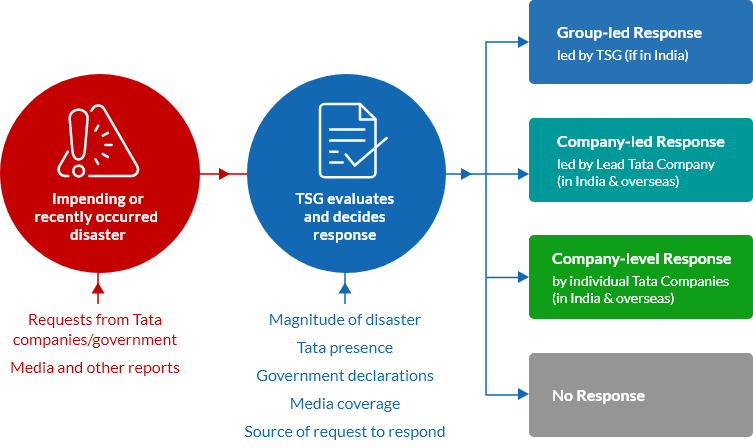The guidelines outline systems that enable decision making to respond effectively and efficiently to disasters and to bring about lasting change for the better, for the communities and areas that are affected. The guidelines set down the broad principle of enabling the Tata ecosystem to respond better to disasters, rather than just writing cheques as a response to communities in need.
The guidelines also lay down the foundational values that underpin any Tata response.
Phases of Disaster Response
The Tata group Disaster Response Guidelines provides the outline in three distinct phases
Rescue
Initial response consists of
rescuing people and providing
emergency services
Timeframe: Up to 45 days
Relief
Phase of relief operations and
initial rehabilitation
Timeframe: Up to 6 months
Rehabilitation
Long-term rehabilitation
efforts to restore community
health and livelihoods
Timeframe: Up to 3-5 years
*The group does not carry out rescue operations and intervenes only to provide emergency relief
Rescue
Rescue, consists of two distinct parts:
1. Rescue Services - which are when rescue operations are on and survivors are still being found. This lasts for up to seven days after the disaster has struck. Rescue operations involve rescuing those who are trapped, making arrangements for casualties and the injured, and trauma counselling.
2. Emergency Services - which begin during or after rescue, and can go up to 45 days. Emergency services consist of distributing emergency relief kits and addressing immediate shelter needs, clearing rubble and debris, restoring communications infrastructure (repairing telephone towers, re-opening roads) and restoring basic public services such as electricity and water supply.
Relief
This phase continues from rescue phase for up to six months, broadly covering activities that help impacted communities regain a sense of normalcy by assessing needs and distributing relief kits, building temporary shelters and continuing work on restoring communications infrastructure and basic public services from the previous phase.
Rehabilitation
This phase continues from relief phase for up to three to five years, broadly including rebuilding of homes and public infrastructure, rebuilding livelihoods and addressing the longer term needs of vulnerable communities.
While rescue phase happens under chaotic conditions with severe information lacunae, the relief and rehabilitation phases are well planned with articulated objectives and a strategy to achieve them.
Types of Responses
The guidelines also specify how a particular disaster will be classified as a
 |
Group-led response anchored by TSG with all companies supporting the central system in place or |
 |
Company-led response where the Lead Tata Company anchors the response with companies in the state supporting the efforts; or |
 |
Company-level response where individual companies respond to the needs of impacted communities in the vicinity of their operations |
The classification based on, inter alia, the magnitude of the disaster, media coverage it receives, its declaration as a national disaster, location of the disaster and the extent of the group's presence in the affected area.
How will we respond?
<< back to Disaster Response page





